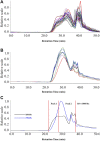Changes of Physicochemical Properties and Immunomodulatory Activity of Polysaccharides During Processing of Polygonum multiflorum Thunb
- PMID: 35784754
- PMCID: PMC9243645
- DOI: 10.3389/fphar.2022.934710
Changes of Physicochemical Properties and Immunomodulatory Activity of Polysaccharides During Processing of Polygonum multiflorum Thunb
Abstract
The roots of Polygonum multiflorum Thunb (PM) have a long history of usage in traditional Chinese medicine and are still widely utilized today. PM in raw or processed form has different biological activities and is commonly used to treat different diseases. Polysaccharides are the main component of PM, and it is unclear whether their physicochemical properties and activities change after processing. In this study, the polysaccharides from thirty-one raw PM (RPMPs) and nine processed PM (PPMPs) were extracted, and the physicochemical properties and immunomodulatory activity in vitro of polysaccharide samples were evaluated. Results showed that RPMPs and PPMPs had significant differences in physicochemical properties. RPMPs and PPMPs were both composed of mannose, rhamnose, glucuronic acid, galacturonic acid, glucose, galactose, and arabinose. However, RPMPs and PPMPs had significant differences in their yields, molecular weight (Mw), and the molar ratio of Glc/GalA (p < 0.05), which can be used to distinguish raw and processed PM. The fingerprint of monosaccharide composition was analyzed by chemometrics, and it was further demonstrated that Glc and GalA could be used as differential markers. The immunomodulatory activity assays indicated that RPMPs and PPMPs could significantly enhance phagocytosis and mRNA expression of cytokines in RAW 264.7 cells. In addition, the immunomodulatory activity of PPMPs with lower Mw was significantly better than that of RPMPs. This study furthers the understanding of the polysaccharides from raw and processed PM and provides a reference for improving the quality standard of PM.
Keywords: Polygonum multiflorum Thunb; fingerprint; immunomodulatory activity; polysaccharides; processing.
Copyright © 2022 Gu, Wang, Jin, Kang, Liu, Zan, Fan, Wei and Ma.
Conflict of interest statement
The authors declare that the research was conducted in the absence of any commercial or financial relationships that could be construed as a potential conflict of interest.
Figures







Similar articles
-
Purification and Structural Characterization of Polysaccharides from Polygonum multiflorum Thunb. and Their Immunostimulatory Activity in RAW264.7 Cells.Foods. 2024 Mar 19;13(6):932. doi: 10.3390/foods13060932. Foods. 2024. PMID: 38540922 Free PMC article.
-
Comparisons of physicochemical features and hepatoprotective potentials of unprocessed and processed polysaccharides from Polygonum multiflorum Thunb.Int J Biol Macromol. 2023 Apr 30;235:123901. doi: 10.1016/j.ijbiomac.2023.123901. Epub 2023 Mar 3. Int J Biol Macromol. 2023. PMID: 36871693
-
An effective strategy for distinguishing the processing degree of Polygonum multiflorum based on the analysis of substance and taste by LC-MS, ICP-OES and electronic tongue.J Pharm Biomed Anal. 2021 Oct 25;205:114328. doi: 10.1016/j.jpba.2021.114328. Epub 2021 Aug 13. J Pharm Biomed Anal. 2021. PMID: 34418675
-
Polygonum multiflorum Thunb.: A Review on Chemical Analysis, Processing Mechanism, Quality Evaluation, and Hepatotoxicity.Front Pharmacol. 2018 Apr 16;9:364. doi: 10.3389/fphar.2018.00364. eCollection 2018. Front Pharmacol. 2018. PMID: 29713283 Free PMC article. Review.
-
Phytochemistry, pharmacology, toxicology and detoxification of Polygonum multiflorum Thunb.: a comprehensive review.Front Pharmacol. 2024 Jun 17;15:1427019. doi: 10.3389/fphar.2024.1427019. eCollection 2024. Front Pharmacol. 2024. PMID: 38953108 Free PMC article. Review.
Cited by
-
Molecular anti-tumorigenic mechanism of Radix Polygoni Multiflori-derived exosome-like nanoparticles.Heliyon. 2025 Jan 22;11(4):e41918. doi: 10.1016/j.heliyon.2025.e41918. eCollection 2025 Feb 28. Heliyon. 2025. PMID: 40028544 Free PMC article.
-
An Analysis of Polysaccharides from Eight Plants by a Novel Heart-Cutting Two-Dimensional Liquid Chromatography Method.Foods. 2024 Apr 12;13(8):1173. doi: 10.3390/foods13081173. Foods. 2024. PMID: 38672845 Free PMC article.
-
Application of digital-intelligence technology in the processing of Chinese materia medica.Front Pharmacol. 2023 Aug 24;14:1208055. doi: 10.3389/fphar.2023.1208055. eCollection 2023. Front Pharmacol. 2023. PMID: 37693890 Free PMC article. Review.
-
Purification and Structural Characterization of Polysaccharides from Polygonum multiflorum Thunb. and Their Immunostimulatory Activity in RAW264.7 Cells.Foods. 2024 Mar 19;13(6):932. doi: 10.3390/foods13060932. Foods. 2024. PMID: 38540922 Free PMC article.
-
Study on the Structural Features of Eight Dendrobium Polysaccharides and Their Protective Effects on Gastric Mucosa.Foods. 2024 Sep 23;13(18):3011. doi: 10.3390/foods13183011. Foods. 2024. PMID: 39335939 Free PMC article.
References
-
- Bradford M. M. (1976). A Rapid and Sensitive Method for the Quantitation of Microgram Quantities of Protein Utilizing the Principle of Protein-Dye Binding. Anal. Biochem. 72, 248–254. 10.1006/abio.1976.9999 PubMed Abstract | 10.1006/abio.1976.9999 | Google Scholar - DOI - DOI - PubMed
-
- Chen Q., Zhang S.-z., Ying H.-z., Dai X.-y., Li X.-x., Yu C.-h., et al. (2012). Chemical Characterization and Immunostimulatory Effects of a Polysaccharide from Polygoni Multiflori Radix Praeparata in Cyclophosphamide-Induced Anemic Mice. Carbohydr. Polym. 88, 1476–1482. 10.1016/j.carbpol.2012.02.055 10.1016/j.carbpol.2012.02.055 | Google Scholar - DOI - DOI
-
- Chen W., Wang P., Chen H., Xing Y., Liu C., Pan G., et al. (2021). The Composition Differences between Small Black Beans and Big Black Beans from Different Habitats and its Effects on the Processing of Polygonum Multiflorum . Phytochem. Anal. 32, 767–779. 10.1002/pca.3022 PubMed Abstract | 10.1002/pca.3022 | Google Scholar - DOI - DOI - PubMed
-
- Dong Q., Li N., Li Q., Zhang C. E., Feng W. W., Li G. Q., et al. (2015). Screening for Biomarkers of Liver Injury Induced by Polygonum Multiflorum: a Targeted Metabolomic Study. Front. Pharmacol. 6, 217. 10.3389/fphar.2015.00217 PubMed Abstract | 10.3389/fphar.2015.00217 | Google Scholar - DOI - DOI - PMC - PubMed
-
- DuBois M., Gilles K. A., Hamilton J. K., Rebers P. A., Smith F. (1956). Colorimetric Method for Determination of Sugars and Related Substances. Anal. Chem. 28, 350–356. 10.1021/ac60111a017 10.1021/ac60111a017 | Google Scholar - DOI - DOI
LinkOut - more resources
Full Text Sources

